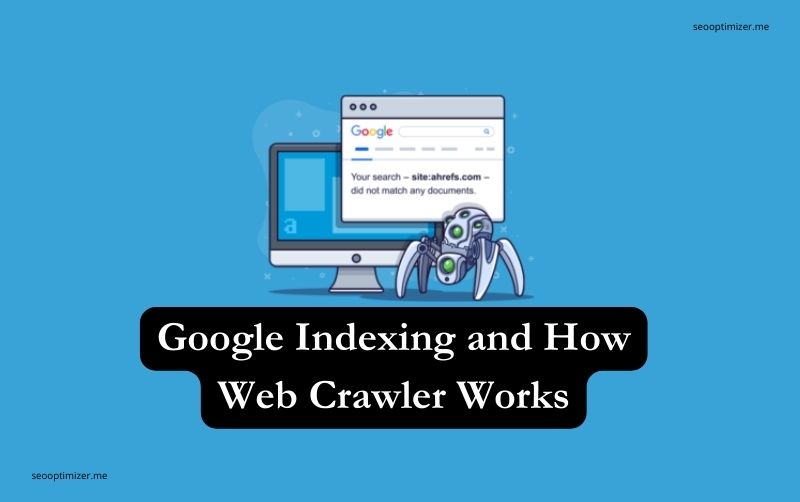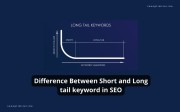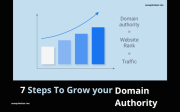Google Indexing and How Web Crawler Works - Comprehensive Guide

What is Google Indexing?
Google indexing is the process by which Google's search engine collects, parses, and stores data from web pages. The goal is to create an index that can be quickly searched to provide relevant and timely results for user queries. In simpler terms, Google indexing is akin to creating a massive library catalog where each web page is a book, and the index is a reference system that helps users find the information they seek.
The Importance of Google Indexing
Imagine the internet without a search engine index, you would understand that it will be very difficult to find relevant and useful information. Google indexing makes the internet accessible by organizing and categorizing information. When you perform a search on Google, you are essentially querying this index to find the most relevant results.
Also read: Website Speed Checker - 5 Best tools For Testing Website Speed
Also read: SEO Education - 5 Reasons Why SEO Isn't Taught in Universities
How Google Indexing Works
Google's indexing process involves several key steps:
1. Crawling: Google uses automated programs called web crawlers (or spiders) to systematically browse the web. These crawlers start by fetching a few web pages and then follow the links on those pages to discover new URLs. This process continues, creating a vast network of interconnected pages.
2. Parsing: Once a web page is crawled, the crawler parses the content of the page. Parsing involves breaking down the HTML, CSS, and other code to understand the structure and content of the page. This step is crucial for extracting relevant information and understanding the context of the page.
3. Storing Information: After parsing, the relevant information from the web page is extracted and stored in Google's index. This information includes keywords, meta tags, images, and other elements that contribute to the page's content and relevance.
4. Indexing: The stored information is then organized and indexed based on various factors such as keywords, page structure, and relevance. The index is like a massive database that allows Google's search algorithms to quickly retrieve relevant results when a user enters a search query.
5. Ranking: When a user performs a search, Google's algorithms analyze the indexed information to determine the most relevant results. The results are then ranked based on factors like relevance, page authority, and user experience. The goal is to present the user with the most useful and authoritative information.
Also read: 268 Popular SEO keywords
Read also: 145 SEO Abbreviations, Acronyms, and Meanings
Factors Affecting Google Indexing
Several factors can influence how and when a web page gets indexed by Google:
1. Quality of Content: Google prioritizes high-quality, relevant content. Pages with valuable information, well-structured content, and appropriate use of keywords are more likely to be indexed.
2. Website Structure: A well-organized website with a clear hierarchy and navigation structure is easier for crawlers to navigate. XML sitemaps and robots.txt files also play a role in guiding crawlers through a site.
3. Page Speed: Faster-loading pages are preferred by Google. Slow-loading pages may be crawled less frequently, impacting indexing frequency.
4. Mobile Friendliness: With the increasing use of mobile devices, Google gives preference to mobile-friendly pages. Responsive design and mobile optimization contribute to better indexing.
5. Backlinks: Inbound links (backlinks) from reputable websites signal to Google that a page is valuable. Such pages are often crawled and indexed more frequently.
6. Robots Meta Directives: The robots meta tag and robots.txt file provide instructions to crawlers on how to interact with a website. These directives can influence which pages are crawled and indexed.
The Role of Web Crawlers
What are Web Crawlers?
Web crawlers, also known as spiders, bots, or robots, are automated programs designed to browse the internet and systematically collect information from web pages. Think of them as digital explorers that navigate the vast network of interconnected pages on the World Wide Web. Google's web crawler, known as Googlebot, is one of the most well-known examples.
How Web Crawlers Work
The process of web crawling involves several steps:
1. Seed URLs: Web crawlers start with a set of seed URLs, which are the initial web pages they will visit. These seed URLs are often provided by the search engine itself or discovered through other means.
2. Fetching: The crawler begins by fetching the content of the seed URLs. This involves making HTTP requests to the web server hosting the page and retrieving the HTML, CSS, and other resources that make up the page.
Also read: Backlinks for SEO - 8 Effective ways to Acquire High-Quality Backlinks
Read also: 10 Popular SEO Influencers you Should Follow on Social Platforms
Related: 14 Top SEO Experts in the SEO Industry
3. Parsing and Extracting Links: Once the content is fetched, the crawler parses the HTML to extract links to other pages. These links serve as a roadmap for the crawler to navigate the web. The crawler then adds these new URLs to its list of pages to visit.
4. URL Frontier: The list of URLs to visit is often referred to as the "URL frontier." The crawler prioritizes which URLs to visit based on factors like freshness, relevance, and importance. URLs from authoritative websites or those with frequent updates may be given higher priority.
5. Recursion: The process repeats as the crawler follows the links on each page, fetching and parsing the content, and discovering new URLs. This recursive process continues, creating a vast network of interconnected pages.
6. Crawl Budget: Web crawlers operate within a crawl budget, which defines the resources allocated for crawling a website. Factors such as server responsiveness, crawl errors, and website quality can impact the crawl budget.
Googlebot: Google's Web Crawler
Googlebot is Google's web crawler responsible for indexing the vast amount of content on the internet. It operates in several modes, including desktop and mobile, to ensure comprehensive coverage. Here are some key aspects of Googlebot:
1. Crawl Rate: Googlebot's crawl rate determines how often it visits a website. Websites with frequently updated content or high importance may be crawled more often.
2. Rendering: Googlebot renders web pages to understand their visual layout and functionality. This helps Google index content that relies on JavaScript, AJAX, or other dynamic technologies.
3. Respecting Robots Directives: Googlebot adheres to the directives specified in the robots.txt file, which can instruct the crawler on which pages to exclude or prioritize.
4. Crawl Errors: Google Search Console provides webmasters with information about crawl errors encountered by Googlebot. Addressing these errors ensures better indexing and visibility in search results.
Read also: How to Optimize Website Speed For SEO
Also read: 11 Common SEO Mistakes you Should Avoid
Challenges in Web Crawling
While web crawlers play a crucial role in indexing the web, they face various challenges:
1. Dynamic Content: Web pages with dynamic content generated through JavaScript pose challenges for traditional crawlers. Googlebot's rendering capability helps address some of these challenges, but ensuring a website is crawlable is essential.
2. Duplicate Content: Identical or substantially similar content across multiple pages can lead to confusion in indexing. Canonical tags and proper URL structures help address the issue of duplicate content.
3. Crawl Traps: Certain website structures can inadvertently create crawl traps, where a crawler gets stuck navigating a loop of pages indefinitely. Webmasters need to be vigilant in avoiding such traps.
4. Robustness to Changes: The web is dynamic, and websites undergo changes regularly. Web crawlers need to be robust and adaptive to handle changes in content, structure, and technology.
5. Security Concerns: Crawlers must navigate the web responsibly and respect privacy and security considerations. Malicious actors may attempt to block or manipulate crawlers for nefarious purposes.
Best Practices for Google Indexing
For webmasters and website owners, optimizing for Google indexing involves implementing best practices to ensure efficient crawling and indexing. Below are some key guidelines you can follow:
1. Quality Content
Creating high-quality, relevant, and unique content is foundational to Google indexing. Content that addresses user intent and provides value is more likely to be crawled and indexed.
2. XML Sitemaps
XML sitemaps serve as a roadmap for search engine crawlers, providing information about the structure and hierarchy of a website. Including an XML sitemap helps search engines understand the organization of content.
3. Robots.txt
The robots.txt file allows webmasters to provide directives to web crawlers about which pages to crawl or ignore. Properly configuring the robots.txt file is essential for guiding crawlers through a website.
With the increasing prevalence of mobile devices, ensuring that a website is optimized for mobile is crucial. Google prioritizes mobile-friendly pages, and mobile optimization contributes to better indexing.
5. Page Speed
Faster-loading pages enhance user experience and are favored by search engines. Optimizing page speed contributes to more frequent crawling and indexing.
6. Backlink Quality
Quality backlinks from authoritative websites signal to search engines that a page is valuable. Building a healthy backlink profile can positively impact indexing and ranking.
7. HTTPS
Securing a website with HTTPS not only enhances security but also influences search engine rankings. Google has indicated a preference for secure, encrypted websites.
8. Monitoring Crawl Errors
Regularly monitoring crawl errors through Google Search Console allows webmasters to identify and address issues that may hinder indexing.
9. Avoiding Duplicate Content
Using canonical tags and implementing proper URL structures helps prevent issues related to duplicate content, ensuring that search engines index the preferred version of a page.
10. Regular Updates
Frequently updating content signals to search engines that a website is active and relevant. Fresh content is more likely to be crawled and indexed.
Also read: What is SEO Analyzer
Read also: What is SEO Optimizer
Future Trends in Google Indexing
As technology evolves, so does search engine indexing. Several trends are shaping the future of Google indexing including:
1. Core Web Vitals
Google has placed increasing emphasis on user experience, and Core Web Vitals are a set of metrics that measure aspects such as page loading speed, interactivity, and visual stability. Websites that prioritize these factors are likely to see benefits in indexing and ranking.
2. Mobile-First Indexing
With the majority of searches now happening on mobile devices, Google has shifted to mobile-first indexing. This means that Google primarily uses the mobile version of a site's content for indexing and ranking.
3. Natural Language Processing (NLP)
Advancements in natural language processing enable search engines to better understand the context and intent behind user queries. This trend is leading to more sophisticated indexing algorithms that consider the nuances of human language.
4. Video and Visual Search
The rise of visual search and the popularity of video content are influencing how search engines index multimedia content. Google is increasingly adept at understanding and indexing visual elements within web pages.
5. Voice Search
As voice-activated devices become more prevalent, the way people search is evolving. Search engines are adapting to the nuances of voice queries, impacting how content is indexed and presented in search results.
6. E-A-T (Expertise, Authoritativeness, Trustworthiness)
Google places a high value on the expertise, authoritativeness, and trustworthiness of a website's content. Websites that demonstrate these qualities are more likely to be indexed and ranked favorably.
What's Next –
Start SEO Optimization. Analyze your website with Free SEO Optimizer
Audit your website for Free - SEO audit free




